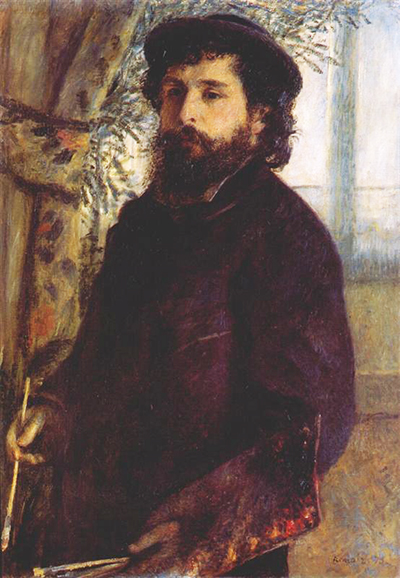Pierre-Auguste Renoir's portrait of his friend and fellow-Impressionist Claude Monet, which hangs in the Musée d'Orsay in Paris, was painted during the year of 1875
In this portrait, Monet is represented as being busily at work on a painting of his own, wearing his working frock and holding his colour palette and paint brushes.
He stands at a window, gazing up momentarily from his work, with the light from behind him illuminating his face – making this the central focus of the painting, with the deeper blue of his clothes serving as a counterbalance.
An oleander tree branch serves to frame the scene, and even perhaps to symbolically crown Monet as a titan of the then-nascent French Impressionist movement – a humorous nod of deference from Renoir to his colleague and friend, and likely representative of the relaxed, and yet productive relationship the two painters shared.
In this portrait of Claude Monet, the familiar techniques of the Impressionist movement are seen: the jagged, repetitive brush strokes effectively capture the transient nature of the sunlight pouring through the window; Monet, though standing still, gives the impression of only doing so for a moment, and of being poised to move again, and to return to his own work as a painter.
In addition, and as with other paintings by Renoir from this period - such as The Swing (1876), or Dance at Le Moulin de la Galette (also 1876) - there is a tone of relaxed informality on display – further emphasising the fact that the moment being depicted by Renoir in the medium of paint is temporal, temporary and fleeting, and will not come again.
The choices of colour in this particular portrait (beige and white, offset by both deeper and lighter shades of blue) are typical of Renoir paintings of this period - such as A Girl with a Watering Can (1876), and Portrait of Alphonsine Fournaise (1879) - and can even be said to be well representative of the Impressionist movement as a whole (for example, Claude Monet's own Impression, Sunrise (1872), which uses a similar colour-scheme – although in a slightly more subtle and understated way).
The theme of portraiture is one which was of much interest to Pierre-Auguste Renoir, and one which had been of interest to both himself and Monet since their days under the tutelage of Charles Gleyre in Paris – this despite their various dalliances with other forms, such as landscapes and scene-sketching.
Renoir preceded his portrait of Claude Monet with his Portrait of Alfred Sisley (1868) - a work in which he again showed a fondness for making visual representations of his fellow artists (Sisley was an Impressionist colleague of Renoir's, of British descent). The theme of portraiture in Renoir's paintings continues through his later works, such as his Portrait of Charles and Georges Durand-Ruel (1882), and Girl Braiding Her Hair (1885).




